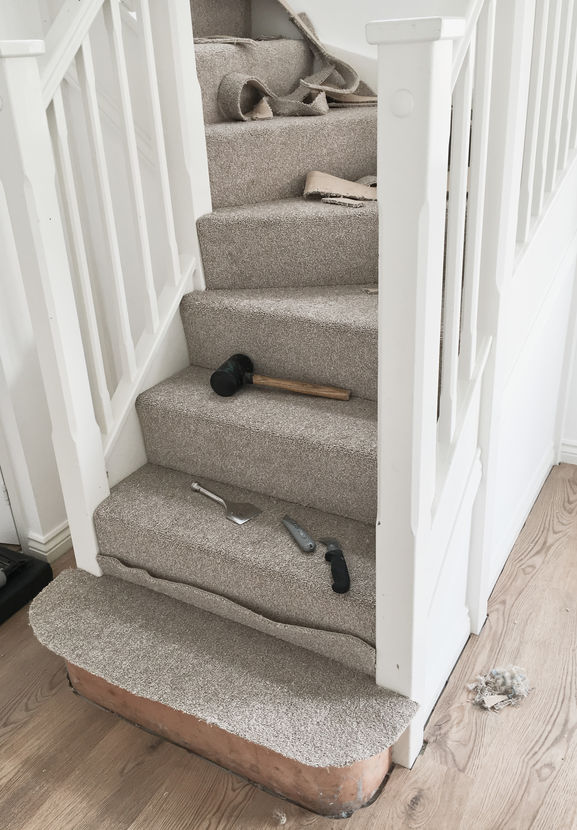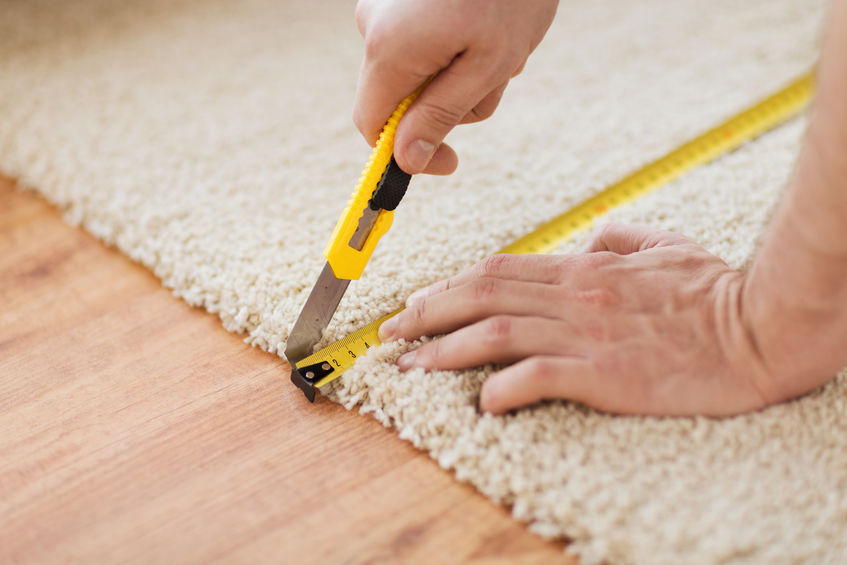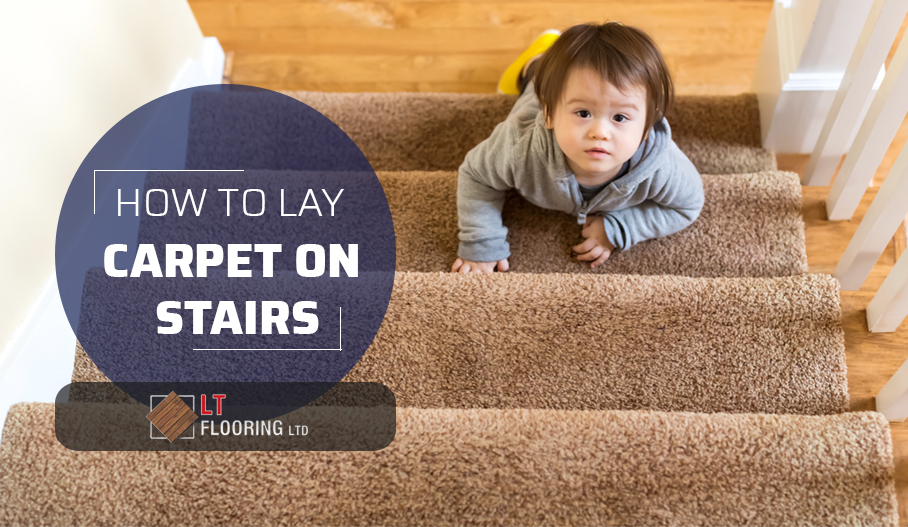Carpeting the stairs is a functional and stylish investment in your home. While carpet creates a soft and comfortable look, which makes a house feel more inviting, the benefits extend beyond aesthetic appeal alone. A carpeted staircase would be much safer than a hard surface since they’re usually less slippery. Even if falls were to occur, the padding of carpeting could prevent serious injuries too. What’s more, carpeted stairs are quieter, because they absorb the impact of footsteps, which is important in such a heavily trafficked area.
Laying carpet on stairs can be a difficult and time-consuming task, especially for novices. That is why most people would suggest calling in an expert. However, if you would prefer to carry out the work yourself, it can be done. If you want to learn how to lay carpet on stairs, these instructions make the project a much easier one for any handyman or handywoman to carry out themselves.
Preparation for Laying Carpet on Stairs
Before you can start laying carpet on stairs, you must make preparations. If you already have carpeting installed, make sure you remove that first. It’s also important that you clear away any old underlay, along with nails, tacks, and staples. Leaving these materials behind could not only ruin your new carpet but harm you too. Once every stair is clear, you should take the opportunity to clean each one. Most staircases require little more than a vacuum, but you might wish to wipe yours down with warm water and soap too.
Once the stairs are clean, you must work out how much carpet you need. After all, you don’t want to waste time purchasing too little or money purchasing too much. To calculate how much carpet is required, you need to measure the size of your staircase. Start by measuring a single step from the bottom of the riser to the back of the tread. Make sure you measure the nose too, which is where the tread hangs over the riser. Just to be safe, you should add an extra inch to this measurement before multiplying it by the number of stairs.

The practical stage of installing a carpet can’t begin until you have carpeting to install. Because of this, you should get in touch with flooring suppliers. Speak to them about your project and expectations for an end result. Chances are, a carpeting expert will be able to offer some helpful advice, as well as suggest carpet types that will suit your needs.
Materials & Tools Needed for Fitting Stair Carpet
The most important ingredients in any home improvement concoction are the supplies. Without the right materials and tools, you can’t even attempt fitting stair carpet. Thankfully, most carpet laying tools are relatively inexpensive, so you won’t have to spend a small fortune. Unless you already have all the supplies, here are several essentials you need for laying carpet on stairs:
- Carpeting
- Underlay
- Tack strips
- Sharp utility knife
- Knee kicker
- Heavy-duty staple gun
- Hammer
When buying carpet for stairs, purchasing a standard-sized runner strip is much easier. Unfortunately, that option isn’t always available. When that is the case, you should cut a piece of carpet to the width of your staircase. Whatever carpet you choose must be hard-wearing, as this will enable it to withstand heavy foot traffic. Underlay is used to reduce wear on carpets, so it makes sense to choose a durable option here too. A hard-wearing underlay will also provide better heat, sound, and moisture insulation.
Tack strips, also known as tackless strips, act as an anchoring base for carpeting. The strips are constructed with small carpet tacks attached, which eliminates the need for individual tacks. Having a hammer makes installing tack strips easy, especially to wood or plywood subfloors. You can find this essential on sale at various websites online, along with most hardware stores.
For Floor Fitters – Call: 01206 575222
Unless you’ve installed carpeting before, you might not know what a knee kicker is. This small tool is essential when laying stair carpet because it allows you to stretch carpeting in a small space. Once you get the hang of using your knee kicker, you’ll never want to install carpet without one again. Like tack strips, you can buy your own knee kicker from hardware outlets.
Most carpet fitters prefer hooked blades because the blade remains sharp for longer. Carpet will blunt most blades very easily, with many rooms requiring up to ten blades. Unless you want to waste time and money replacing your blades, you should use a sharp utility knife. A heavy-duty staple gun is also needed to secure the underlay to the floor before you lay the carpeting down.
How to Fit Stair Carpet

When the time comes to lay your stair carpet, you must begin with the tack strips. These strips will secure your carpeting to the stairs, making it safe to walk on. Make sure you affix the strips to the tread of each stair, having the angled edge facing away. Remember to leave a gap between the tack strip and the riser of about three-quarters of the thickness of the carpeting. Tack strips should also be fixed to the riser, with the angled edge facing down this time. Repeat this on every stair, but don’t put a tack strip on the bottom step.
Underlay forms a foundation for a carpet. This padding is a squishy material, which provides a soft underfoot and extends the lifetime of carpeting. After affixing every tack strip, you should cut pieces of underlay to fit the tread. These pieces should fit between the strips on each stair. If every step is the same, you can make a template to cut your underlay pieces with. Once those pieces are prepared, you should secure them to the staircase using a heavy-duty staple gun.
Once the base and foundation are prepared, you can pick up your carpeting. Take the strip of stair carpet and roll it up, leaving the underside facing outwards. Make sure you start at the bottom step, with the pile looking down the staircase. This will keep it from getting rubbed the wrong way when it’s stepped on. Tack the carpet strip to the bottom of the first riser and then pull it over the first step. Using the knee kicker, you should stretch the carpet to keep it from rucking up later. The bolster can then be used to push the carpet between the strips at the corner.
Many stairs have a nose, which can cause problems if not dealt with properly. When fitting stair carpet over a nose, you must tack the carpet under it. Unless you do this, the carpet will stretch over the nose, leaving a gap from the bottom of the riser to the top.
After finishing one stair, you should repeat the process with every other step, until you reach the top. When carpeting the landing with the same carpet, you have two options. Some people continue with a single piece of carpeting along the landing, but that isn’t always possible. If that method wouldn’t work for you, make sure you trim the carpet in a neat line. This would allow you to affix the landing carpet where the stair carpet ended much easier. Whatever you do, remember to cut any excess carpet from the bottom step too.
Laying carpet on stairs can definitely be tricky. If you’re unsure of your skills, then you should consider calling a professional to help. However, with the instructions above, anyone with basic DIY know-how should be able to fit stairs carpet themselves.


